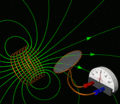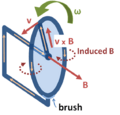Faraday's law of induction facts for kids
Faraday's law of induction is a law of physics proposed by English physicist Michael Faraday in 1831. It is one of the basic laws of electromagnetism. The law explains why generators, transformers and electrical motors work.
Faraday's law of induction says that when a magnetic field changes, it causes a voltage, a difference in the electric potential that can make electric currents flow. That phenomenon was also found by Joseph Henry in 1831.
Imagine we have a closed loop of wire. To figure out how much current will be "induced" (i.e. produced by the magnetic field), we need to define the magnetic flux, a number describing how much of the magnetic field is actually going through the loop. Magnetic fields are vector fields, so they have both a strength and a direction. This leads to the following surface integral:
where
- ΦB is the magnetic flux
 is the (possibly moving) surface whose boundary is the wire loop
is the (possibly moving) surface whose boundary is the wire loop- B is the magnetic field
- dA is a small part of the surface.
That is, we could imagine filling in the wire loop with a thin surface, like a soap film. This formula tells us to look at every point on that surface, measure how much the magnetic field is pointing straight through the loop at that point, and add up all those measurements to get a single number. That number is the magnetic flux. When the flux changes, it produces electromotive force. The flux changes when B changes or when the wire loop is moved or bent, or when both happen. The electromotive force can then be calculated with the following equation:
 is the electromotive force
is the electromotive force- N is the number of loops the wire makes
- ΦB is the magnetic flux of one loop
- - is representative of Lenz's law and indicates direction of the electromotive force
This equation says that how much current is induced in the wire loop depends directly on how fast the magnetic flux is changing in time, whether due to the loop moving or the magnetic field changing.
History
Electromagnetic induction was discovered independently by Michael Faraday in 1831 and Joseph Henry in 1832. Faraday was the first to publish the results of his experiments.
Faraday's notebook on August 29, 1831 describes an experimental demonstration of electromagnetic induction (see figure) that wraps two wires around opposite sides of an iron ring (like a modern toroidal transformer). His assessment of newly-discovered properties of electromagnets suggested that when current started to flow in one wire, a sort of wave would travel through the ring and cause some electrical effect on the opposite side. Indeed, a galvanometer's needle measured a transient current (which he called a "wave of electricity") on the right side's wire when he connected or disconnected the left side's wire to a battery. This induction was due to the change in magnetic flux that occurred when the battery was connected and disconnected. His notebook entry also noted that fewer wraps for the left side resulted in a greater disturbance of the galvanometer's needle.
Within two months, Faraday had found several other manifestations of electromagnetic induction. For example, he saw transient currents when he quickly slid a bar magnet in and out of a coil of wires, and he generated a steady (DC) current by rotating a copper disk near the bar magnet with a sliding electrical lead ("Faraday's disk").

Michael Faraday explained electromagnetic induction using a concept he called lines of force. However, scientists at the time widely rejected his theoretical ideas, mainly because they were not formulated mathematically. An exception was James Clerk Maxwell, who in 1861–62 used Faraday's ideas as the basis of his quantitative electromagnetic theory. In Maxwell's papers, the time-varying aspect of electromagnetic induction is expressed as a differential equation which Oliver Heaviside referred to as Faraday's law even though it is different from the original version of Faraday's law, and does not describe motional emf. Heaviside's version is the form recognized today in the group of equations known as Maxwell's equations.
Lenz's law, formulated by Emil Lenz in 1834, describes "flux through the circuit", and gives the direction of the induced emf and current resulting from electromagnetic induction (elaborated upon in the examples below).
According to Albert Einstein, much of the groundwork and discovery of his special relativity theory was presented by this law of induction by Faraday in 1834.
Images for kids
-
Faraday's experiment showing induction between coils of wire: The liquid battery (right) provides a current which flows through the small coil (A), creating a magnetic field. When the coils are stationary, no current is induced. But when the small coil is moved in or out of the large coil (B), the magnetic flux through the large coil changes, inducing a current which is detected by the galvanometer (G).
-
A Left Hand Rule for Faraday's Law. The sign of ΔΦB, the change in flux, is found based on the relationship between the magnetic field B, the area of the loop A, and the normal n to that area, as represented by the fingers of the left hand. If ΔΦB is positive, the direction of the emf is the same as that of the curved fingers (yellow arrowheads). If ΔΦB is negative, the direction of the emf is against the arrowheads.
-
Faraday's homopolar generator. The disc rotates with angular rate ω, sweeping the conducting radius circularly in the static magnetic field B (which direction is along the disk surface normal). The magnetic Lorentz force v × B drives a current along the conducting radius to the conducting rim, and from there the circuit completes through the lower brush and the axle supporting the disc. This device generates an emf and a current, although the shape of the "circuit" is constant and thus the flux through the circuit does not change with time.
-
A wire (solid red lines) connects to two touching metal plates (silver) to form a circuit. The whole system sits in a uniform magnetic field, normal to the page. If the abstract path ∂Σ follows the primary path of current flow (marked in red), then the magnetic flux through this path changes dramatically as the plates are rotated, yet the emf is almost zero. After Feynman Lectures on Physics
See also
 In Spanish: Ley de Faraday para niños
In Spanish: Ley de Faraday para niños









